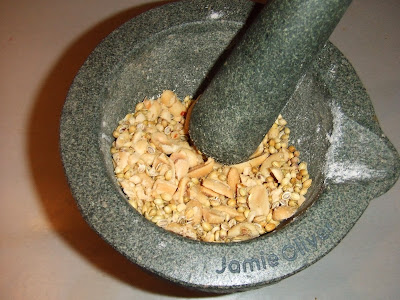In
my previous post I mentioned my new Indian vegetarian (Gujarati) cookbook Prashad by Kaushy Patel, and this is my
first attempt at one of its recipes. This aubergine dish is one of my favourite
curries, and I have always been interested in learning how to make it. When I
saw the beautiful stripy aubergines at Queens Park Farmers’ Market, I knew it
had to be done. Of course once it is cooked you can’t tell that the aubergines
ever looked like anything other than normal aubergines, but I just can’t help
myself when it comes to buying interestingly coloured produce (I also bought a
purple kohlrabi).
I
didn’t have quite the right ingredients to make the exact recipe, so here is my
attempt. Apologies for the lack of post-cooking photo, it was so unbelievably
delicious that I got distracted. Seriously, it was just as good as the versions
I have had in Indian restaurants, and I highly recommend it.
I had
previously seen other versions of this curry that used desiccated coconut, so I
thought that coconut oil would make a nice change instead of using regular oil.
I have also reduced the amount of oil and sugar. The original recipe was onion
and garlic free, using ¼ tsp asafoetida instead, but seeing as I didn’t have
any, I thought I would use onion and garlic, especially as I didn’t have enough
aubergines.
Serves
4 as part of a bigger meal with other dishes, or 2 hungry people with a little
leftover if just served with rice and/or bread (I prefer chapattis to naan
bread).
Ingredients:
150g
peanuts, roughly chopped (you are supposed to use unroasted red-skinned
peanuts, but I couldn’t get hold of any so I used roasted, salted ones.
Apparently Sainsburys are having some sort of nut crisis).
15g
Demerara/soft brown sugar or flaked jaggery
2
tbsp coriander seeds (or 3 tbsp ground coriander)
2
tsp turmeric
1 ¼
tsp salt (use less if you are using salted peanuts)
1
heaped tsp cumin seeds
½
can chopped tomatoes
4cm
root ginger, peeled and roughly chopped
2
cloves garlic, squashed with the flat edge of a knife and roughly chopped
2-3
tsp mild chilli powder, or 1-2 tsp hot chilli powder
2
handfuls fresh coriander, chopped
100ml
coconut oil (In the winter the oil with be solid, and I have found the best way
to melt it so that you can measure it without wasting any, is to submerge the
whole jar in a bowl of hot water for a few minutes)
Little
aubergines – the original recipe called for 16 baby aubergines (aw babies), but
I only had 5 slightly bigger ones. This wasn’t enough, so I would suggest using
16 babies if you can get them, or 8 teenagers.
1
medium sized onion – cut in half and sliced
Put
the peanuts and coriander seeds in a mortar and pestle and grind until it is
all broken down and resembles a coarse powder/crumbs (I use a really heavy
stone one, and I definitely recommend getting one).
Put the crumbs into a large
bowl with the sugar, turmeric, salt, cumin seeds and tomato, mix together and
leave to rest for a few minutes.
Crush
the ginger and garlic in the mortar and pestle, and add it to the peanut spice
mixture along with the chilli powder, chopped coriander and coconut oil. Stir
it all up.
If
you are using onions, heat oil in a large saucepan and put them on to fry on a
medium-ish heat at this point. Stir from time to time, but allow them to
colour.
Using
a very sharp knife, carefully cut the aubergines into quarters lengthways,
leaving a couple of centimetres at the stem so that they stay together. Gently
open them out and use a teaspoon to fill them with the spice mixture, coating
all four wedges of each aubergine, being careful not to split the aubergines
apart. This is a really messy job, and the spice mixture will go everywhere, so
it is probably best to hold the aubergines over the bowl of marinade.
Arrange
the filled aubergines in the pan on top of the onions, and cover with any
remaining spicy marinade – there should be a fair amount. Cover the pan and
cook over a low heat for 5 minutes, and then add in 350ml boiling water –
carefully around the edges so that it doesn’t wash the spice mixture out of the
aubergines. Put the lid back on the pan and bring to the boil, reduce the heat
and let the whole thing simmer for 25-30 minutes, until the aubergines are
tender. If you are using slightly bigger ones, check the pot a few times to
gently turn the aubergines.
If
like me, you don’t have quite enough aubergines and a bit too much liquid,
throw a handful of rice into the pot for the last 10 minutes of cooking time.
The rice will cook in the delicious curry sauce, and absorb the excess liquid.
Kaushy
Patel suggests that you let the dish rest off the heat for 20 minutes after it
is done cooking, and then reheat before serving – to let the flavours infuse even
more. I tried, but after about 5 minutes off the heat it smelt too good so I
ate it straight away.





